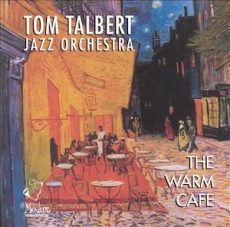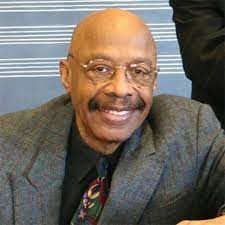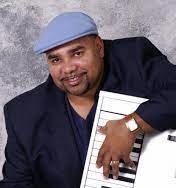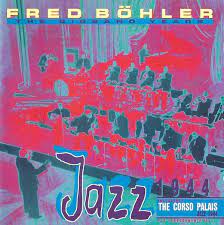
Daily Dose Of Jazz…
Thomas Robert Talbert was born on August 4, 1924 in Crystal Bay, Minnesota and grew up listening to big band music on the radio. He learned to play piano before he became a composer. He got started as a band leader when he was drafted in the Army in 1943, becoming composer for a military band at Fort Ord, California, performing for War Bond drives throughout California.
In the late 1940s he led his own big band on the West Coast, much of his work foreshadowing what became known as West Coast jazz. During the decade in Los Angeles he worked with Johnny Richards, Lucky Thompson, Dodo Marmarosa, Hal McKusick, Al Killian, Art Pepper, Steve White and Claude Williamson…….
Moving to New York in the early 1950s after being denied a recording contract in Los Angeles, California he worked with Marian McPartland, Kai Winding, Don Elliott, Johnny Smith, Oscar Pettiford, Herb Geller, Joe Wilder, Eddie Bert, Barry Galbraith, Aaron Sachs and Claude Thornhill. In 1956, Talbert recorded two records that would become his best known works, Wednesday’s Child and Bix Duke Fats, which gained him fleeting fame.
When rock and roll eclipsed jazz in popularity, in 1960 he moved to his parents’ home in Minnesota. He tried his hand at cattle ranching in Wisconsin but eventually moved back to Los Angeles and a musical career in 1975. As a sideman he recorded with the Boyd Raeburn Orchestra, Johnny Richards, and Patty McGovern.
In addition to composing for TV and movie studios, he became involved in music education, and set up a foundation to help talented young musicians, with one of the first recipients in 1996 was Maria Schneider.
Pianist, composer and band leader Thomas Talbert, who recorded eighteen albums as a leader, transitioned on July 2, 2005 in Los Angeles.
More Posts: bandleader,composer,history,instrumental,jazz,music,piano

Three Wishes
Dwike MItchell was hanging out at the house of the Baroness when she questioned his three wishes and told her:
- “To be able to play for people every night, that is my very special wish. To be able to play consistently well for everyone, to be able to give the best of myself every day. Love me like I love you, darling! For every day is different. Today is dark and black. And if one could give one’s best to everyone, that would be the greatest wish of every musician.”
*Excerpt from Three Wishes: An Intimate Look at Jazz Greats ~ Compiled and Photographed by Pannonica de Koenigswarter
More Posts: baroness,history,instrumental,jazz,music,pannonica,piano,three,wishes

Requisites
Catalonian Nights, Vol. 1 ~ Tete Montoliu Trio | By Eddie Carter
The Tete Montoliu Trio enters the spotlight with a 1980 live trio date, Catalonian Nights, Vol. 1 (SteepleChase Records SCS-1148). It came out a year later and is the first of three releases by the group from the Zeleste Club. Tete was born blind in Barcelona and learned braille music at age seven. His father was a professional musician, and his mother loved jazz, inspiring him to learn the piano. Montoliu attended the Barcelona Conservatori Superior de Música del Liceu at age thirteen. Tete met a few jazz musicians and learned about jam sessions while studying at the music college. He’s joined here by John Heard on bass and Albert Tootie Heath on drums. My copy is the original U.S. Stereo album.
D & E is from the pen of Milt Jackson and gets the set underway with the trio’s medium melody. Everyone has a lengthy canvas to work on, and Tete lets his fingers do the talking on the lead interpretation. John follows, walking his bass as if on a Sunday stroll, then Albert converses with Tete ahead of the close. Montoliu showcases his swinging style on Lady Bird by Tadd Dameron next, beginning with a solo introduction that grows into the ensemble’s spirited melody. Tete’s opening solo is off to an adventurous start; then Heath joins the pianist for a vigorous exchange leading to the theme’s reprise and robust ending.
Autumn In New York by Vernon Duke begins with a beautiful piano introduction that blossoms into a gorgeous ensemble theme. Tete begins the opening statement quietly, then picks up the pace to improvise freely into a satisfying summation. John delivers the following solo with exquisite sensitivity, preceding the closing chorus and tender climax. Kenny Dorham’s Blue Bossa takes off with the trio’s bossa-nova melody. Montoliu makes his entrance with an intriguing interpretation that delivers the goods. Heard speaks his piece next, then Tete and Heath share the finale leading to the melody’s reprise and exit. The trio wraps everything up in short order with The Theme.
Freddy Hansson and Josep Maria Rodon recorded this live performance, and Nils Winther produced it. Catalonian Nights, Vol. 1, is an excellent recording with a superb soundstage that makes listeners feel like they are in the club audience as the trio performs. I first heard The Tete Montoliu Trio on Gentle Ben with Ben Webster and was immediately impressed by his playing. Now that I’ve discovered this album, I’ll be on the lookout for Catalonian Nights, Vol. 2 and Vol. 3. If you’re in the mood for an excellent live album, I offer for your consideration Catalonian Nights, Vol. 1 by The Tete Montoliu Trio. It’s a great release that I highly recommend and a welcome addition to any library!
~ Catalonian Nights, Vol 2 (SteepleChase Records SCS 1241), Catalonian Nights, Vol. 3 (SteepleChase SCCD 31433), Gentle Ben (Ensayo ENY-301) – Source: Discogs.com
~ Autumn In New York – Source: JazzStandards.com
~ Blue Bossa, Lady Bird – Source: Wikipedia.org
© 2023 by Edward Thomas Carter
More Posts: choice,classic,collectible,collector,history,instrumental,jazz,music,piano

TYRONE JACKSON
The name Tyrone Jackson is the quintessential jazz piano player. His boundless creativity coupled with harmonic mastery, utilizes the piano as a blank canvas. Jackson is nationally recognized and has traveled the world as a solo artist and sideman. As a composer, Jackson has composed original music for Pulitizer Prize winning author Natasha Tretheway’s book of poems “Native Guard” turned theatrical play, Pearl Clege’s play, “Tell Me My Dream”, “Ethel” and this year’s Alliance Theater production of “Nick’s Flamingo Grill.” Jackson has recorded 4 Albums—“Dedicated”, “Another Voyage”, “Melody In Nede”, and new release “From The Mind Of.”
Currently Tyrone Jackson is a professor at Kennesaw State University where he is Lecturer of Jazz Piano and teaches a myriad of classes including: Aural Skills III & IV, Jazz Improvisation I, II & III, Jazz Combo, Jazz Theory, Applied Jazz Piano, Group Jazz Piano and History of the Blues. Jackson is also a clinician and teacher for the Rialto Arts Jazz program for middle school and is a clinician for Clayton County Arts Association.
Jackson has performed with Steve Turre, Larry Carlton, Carmen Bradford, Earl Klugh, Wynton Marsalis, Branford Marsalis, Wycliffe Gordon, Vincent Gardner, Joe Lovano, Dave Douglas, Wes Anderson, Greg Dawson, Jennifer Holliday, Karen Briggs, Clay Jenkins, Russell Gunn, David Sanchez, Damaris Carbough, Russell Malone, and Marcus Miller.
Hosted by Lori Williams
More Posts: adventure,club,genius,jazz,music,piano,preserving,travel

Daily Dose Of Jazz…
Alfred “Fred” Böhler was born July 26, 1912 in Zurich, Switzerland. He started on violin as a child but later switched to piano. He led his own ensemble starting in 1936, which featured Eddie Brunner and Hazy Osterwald, among others, as sidemen. This group made several tours of Switzerland during World War II and recorded copiously for Columbia Records.
In 1943, Böhler conducted an orchestral ensemble that played symphonic jazz. While he recorded most often on piano, he also used Hammond organ early in a jazz context. He would eventually play with Marcel Bianchi, Edith Piaf, Josephine Baker, and Pierre Cavall among others.
Pianist, Hammond organist and bandleader Fred Böhler transitioned on January 10, 1995 in Zumikon, Switzerland.
More Posts: bandleader,history,instrumental,jazz,music,organ,piano




